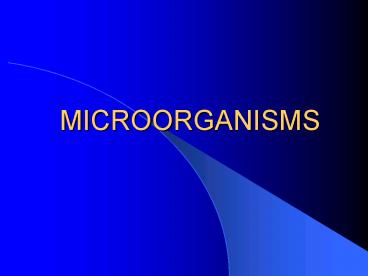MICROORGANISMS - PowerPoint PPT Presentation
1 / 20
Title:
MICROORGANISMS
Description:
MICROORGANISMS Definitions Microorganism: microbe, small living plant or animal that is not visible to the naked eye. Examples: bacteria, protozoa, fungi, rickettsiae ... – PowerPoint PPT presentation
Number of Views:420
Avg rating:3.0/5.0
Title: MICROORGANISMS
1
MICROORGANISMS
2
Definitions
- Microorganism microbe, small living plant or
animal that is not visible to the naked eye. - Examples bacteria, protozoa, fungi,
rickettsiae, and viruses.
3
Definitions
- Nonpathogens microorganisms that are a part of
the normal flora of the body and are beneficial
to maintaining certain body processes. - Pathogens microorganisms that cause infection
and disease . (germs)
4
From one to another
- Microorganisms that are beneficial in one area
of the body, can become harmful if they are
present in another area of the body.. - SO..Nonpathogens can become Pathogens!!
- Example E coli is normal in the large
intestine..and aid in digestion..BUT if E coli
is found in the urinary system or blood it causes
infections.
5
Classifications
- Bacteria one celled plants that multiply
rapidly. - Protozoa one celled animals found in decayed
materials and contaminated water. - Fungi Simple plantlike organisms that live on
dead organic matter.
6
Classifications
- Rickettsiae parasites..cant live outside the
cells of another organism. - Viruses smallest living organism, visable only
with the use of an electron microscope. - They cant reproduce unless they are inside
another living cell.
7
Examples
- Spirilli spiral shaped.
- Causes cholera and syphilis.
8
Examples
- Bacteria
- Cocci- round or spherical shaped, occur in pairs
chains and clusters. - Diplococci pair of cocci
- Streptococci chains (think of a strip of cocci)
- Staphlococci Clusters (think of grapes)
9
ExamplesBacteria continued
- Bacilli rod shaped, occurs singly, in pairs, or
in chains. Some contain flagella (threadlike
projections that are similar to tails that allow
bacilli to move) - Able to form spores (thick walled capsules) when
conditions are poor for growth. - Extremely difficult to kill!
10
Examples
- Protozoa amoeba
- Pathogenic ones cause malaria, amebic dysentery,
trichomonas, and African sleeping sickness.
11
Examples
- Fungi yeast and molds/
- Causes diseases such as ringworm, athletes foot,
histoplasmosis, and thrush.
12
Examples
- Rickettsiae found on fleas, ticks, and lice,
and mites. - Causes diseases such as typhus fever, and Rocky
Mountain spotted fever.
13
Examples
- Viruses HIV and HBV
- Spread from human to human by blood and body
fluids. - Difficult to kill, resistant to disinfectants,
and are not usually affected by antibiotics. - Causes many diseases AIDS, hepatitis B colds,
measles, mumps, chicken pox, herpes, warts, flu
and polio
14
What they NEED!
- Microorganisms NEED
- Warm environment body temperature is ideal
- Darkness again..inside the body is protected
from light..some microbes are immediately killed
by sunlight. - Moisture and Food blood
15
Oxygen vs. Nonoxygen
- Aerobic REQUIRE oxygen.
- Anerobic does NOT REQUIRE oxygen.
- The human body is an ideal supplier of all the
needs of microorganisms.
16
Inside or Outside
- Exogenous infections or disease that originate
OUTSIDE the body. - Endogenous infections or disease that originate
INSIDE the body. - Example tumors, congenital abnormalities, or
metabolic disorders.
17
Nosocomial
- An infection that originates in the health care
facility. - Example
- Post surgical
- Pneumonia
18
Chain of Infection
- Causative Agent
- Pathogen
- Reservoir
- Where Pathogen
- lives
19
Chain of Infection
- Portal of Exit
- Way to escape the reservoir
- Urine , feces, saliva, blood, tears, mucous
discharge, sexual secretions,and draining wounds
20
(No Transcript)




























